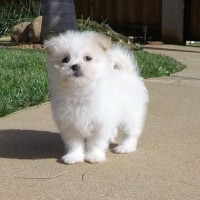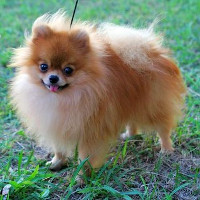Appearance of the Maltipom
|
| Pint-sized, fluffy and utterly adorable, the Maltipom is an irresistible hybrid. With a small wedge-shaped head and a tail that curves over the back, the Pomeranian's Spitz ancestry is obvious. Their dark brown eyes have a mischievous twinkle and are hard to resist when used to beg for treats. While some dogs of the breed will have erect ears, others will have semi-erect or collapsed ears like their Maltese relatives. Their bodies are small but sturdy, and they have small, delicate legs. Measuring 18 to 21 cm and weighing just 2 to 4 kg, the Maltipom is one of the smallest hybrids on the market. When left full length, Maltipom fur can be very long and dense, although many will choose to reduce it, as avoiding cores and tangles can require a lot of dedication. Their fur is soft to the touch and generally hypoallergenic, and rarely sheds much. Most will have a white or cream coat, but fawn, brown, gray and black are also possible. |
Temperament of the Maltipom
|
| Given that both parents were kept as pets and family animals for many years, it's not surprising that the Maltipom is a sociable, well-adjusted crossbreed. Gentle and affectionate, they form close bonds with their families, but require supervision when around young children due to their very small size and delicate bone structure. A formidable little watchdog, the faithful Maltipom is always on the alert and more than happy to alert its owner to the arrival of any new person. Of course, their friendly nature and small size make them unsuitable guard dogs, although they don't seem to realize it. They have a reputation for barking incessantly at strangers, a bad habit that owners should try to remedy from an early age. Some dogs will form a closer relationship with one person, perhaps the one who feeds them or spends the most time with them. They will tend to pay more attention to that person, and this can be helpful if that person is the one who trains them. |
Needs and activities of the Maltipom
|
| The Maltipom has a low energy level and doesn't require much exercise. A brief burst of energy in the living room as the Maltipom rushes into your lap for a cuddle is characteristic of this dog. The intensity of the exercise is not great either, and the Maltipom is a fairly serene companion. Given its size and energy level, the Maltipom is an excellent dog for apartment and city living, and can spend most of its life indoors. The Maltipom is a temperate-climate dog and doesn't like it too hot or too cold. |
Maintenance of the Maltipom
|
| The Maltipom has a beautiful coat that requires regular brushing and combing to maintain. Gently brush the Maltipom's coat with a brush or comb to remove knots and dirt. Using a gentle stream of water will also help, but don't bathe the Maltipom unless necessary. White-coated dogs can develop tear stains, but using a pet wipe to clean the eyes and face can prevent fatigue. Long hair on the head can trap dirt and debris in Maltipom's ears. It's wise to check your dog's ears and clean them if necessary during grooming. |









 English (United Kingdom)
English (United Kingdom)